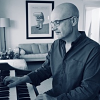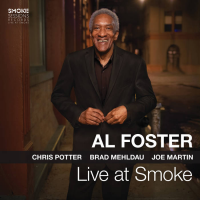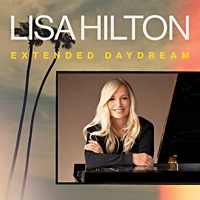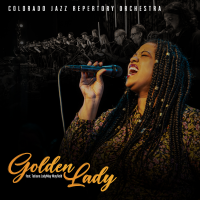Home » Jazz Musicians » Larry Young
Larry Young
A true innovator on the Hammond B3, Young took a different musical path than any of the other organ masters of his time: Although he started out drawing his major influences from the work of Jimmy Smith and the gospel and blues elements that other players employed, but eventually turned to a more complex, modal approach to the organ with sophisticated harmonic and chordal structure
Larry Young was born on October 7, 1940, and hails from Newark, New Jersey. His background includes study of both classical and jazz music on the piano, but had a natural family bond with the organ. Larry Young, Senior, his father, was an organist and was the first major musical influence on his son. The father, moreover, provided an organ in the family home so that Larry Young, Junior, who had studied piano, could gravitate easily and at his own pace to the organ. In his teen years, Young was relatively inactive musically; but a reawakened interest in the organ, encouraged by his father, propelled Young into music in 1958. After a rhythm and blues apprenticeship, Young gained wider experience with Lou Donaldson; worked around New York and New Jersey with Kenny Dorham, Hank Mobley and Tommy Turrentine, among others; and then began heading his own units.
He recorded his first sides for Prestige in 1960 with the offering “Testifying,” followed up with “Young Blues,” the same year, then into “Groove Street,” in ’62. He jumped over to the Blue Note label, and in ’64 put out “Into Somethin.” Young's premier album is thought to be "Unity", with Joe Henderson, Woody Shaw, and Elvin Jones, which came out in 1965. This is considered to be his best outing, and still holds up as a hard bop organ classic. Young’s work for Blue Note (as both a leader and a sideman) was compiled for Mosaic's limited-edition six- CD box set “The Complete Blue Note Recordings.”
Young was attracted to the novel concept of fusion, he played with Miles Davis in 1969, on the “Bitches Brew,” sessions, worked with John McLaughlin, and then Tony Williams' groundbreaking 'Lifetime' in the early '70's, where he was an important third of that band, one of the first jazz fusion groups. From here he recorded two solo albums for Arista, “Larry Young's Fuel,” (1975) and “Spaceball.” (1976)
Larry Young was only 38 when, in 1978, he checked into a hospital suffering from stomach pains, and died from untreated pneumonia.
Read moreTags
Larry Young, Steven Bernstein, and Karrin Allyson

by Jerome Wilson
Despite an equipment malfunction during the third set, this show covers a variety of artists from the last seventy years of jazz. Musicians heard include Larry Young, Steven Bernstein, Dennis Gonzalez, Karrin Allyson, and Hampton Hawes. Playlist Henry Threadgill Sextett “I Can't Wait Till I Get Home" from The Complete Novus & Columbia Recordings of Henry Threadgill & Air (Mosaic) 00:00 Dennis Gonzalez “The Earth and the Heart Suite: Part 3--The Earth and the Heart" from The Earth ...
Continue ReadingElvin Jones: Revival: Live at Pookie's Pub

by Angelo Leonardi
Non c'è solo la musica --tumultuosa e avvincente-- a porre in primo piano questo doppio CD (o triplo LP) del quintetto di Elvin Jones, ripreso in un piccolo club di Manhattan dal 28 al 30 luglio 1967. L'edizione fortemente voluta da Zev Feldman (dopo 11 anni di tentativi presso varie etichette) illustra il punto di svolta del batterista da illustre sideman a leader e illumina la singolare condizione del jazz a New York nella seconda metà dei ...
Continue ReadingElvin Jones: Revival: Live At Pookie’s Pub

by Mike Jurkovic
No matter your format of choice—the deluxe 180g 3-LP set, streaming, or a 2-CD package--there is some serious, late '60s hard bop soul-searching happening on this eye-opening, mind-expanding, previously unreleased Revival: Live at Pookie's Pub. Elvin Jones cleared the cobwebs just two weeks after John Coltrane's passing and the resounding end to the classic quartet of Coltrane, Jones, McCoy Tyner and Jimmy Garrison. The writing had been on the wall that Coltrane was more than ready and eager ...
Continue ReadingElvin Jones: Revival: Live At Pookie’s Pub

by Chris May
A welcome addition to Elvin Jones' catalogue, the previously unissued 2 x CD / 4 x LP Revival: Live At Pookie's Pub was recorded in New York in July 1967. The gig was just two weeks after the passing of John Coltrane, with whom Jones had played from 1960 to 1966. Jones' quartet includes the gritty but underrated tenor saxophonist Joe Farrell, who had the unenviable job of standing in Coltrane's shadow. But he rises to the occasion magnificently. Jones ...
Continue ReadingMother Ship's 50th Anniversary, Bu @ 100 & More

by Marc Cohn
Who took the happiness out? Not Gifts & Messages! This week we celebrate the 50th anniversary for the Blue Note album Mother Ship by Larry Young. Also featured is Blue Note No. 6 from Sidney Bechet and three tracks to start the Art Blakey centennial celebration, including a rare (and powerful) one from Gypsy Folk Tales. Oczywiście, there's more! Gifts & Messages is the antidote for the Polar Vortex.... Playlist Dirty Dozen Brass Band “Who Took ...
Continue ReadingIn Paris: The ORTF Recordings

by Maurizio Comandini
Ogni tanto gli archivi sparsi nel nostro pianeta si aprono per regalare belle e rare emozioni agli attenti cittadini del mondo della musica. Non è cosa così semplice come potrebbe apparire superficialmente: per trovare questi tesori nascosti serve anche l'energia di un gruppo di persone che si appassiona e si mette a caccia delle cose nascoste nelle pieghe del tempo e della storia. In questo caso l'archivio è quello della radio e televisione francese (ORTF) e il manipolo di appassionati ...
Continue ReadingLarry Young: In Paris: The ORTF Recordings

by Mark Corroto
You may know organist Larry Young from his work in The Tony Williams Lifetime band (with John McLaughlin) and later with Jimi Hendrix, and Carlos Santana or you may just be hip to his Blue Note 1960's years. Nonetheless, you would certainly be surprised to learn that he lived to be just 38 years old, passing away in 1978. As the philosopher Lao Tzu said, “The flame that burns twice as bright, burns half as long" Born Larry ...
Continue ReadingBackgrounder: Larry Young - Into Somethin', 1964

Source:
JazzWax by Marc Myers
Larry Young was unlike any organist who preceded him. Rather than channel the Black church, he was more influenced by R&B and John Coltrane's tenor saxophone and chord changes on original pieces. One of Young's best middle-period albums—between his early soul-jazz recordings and his modal, avant-garde LPs—is Into Somethin', his first leadership work for Blue Note. If you listen carefully to Young's organ, you'll hear the Coltrane influence and how modern it sounds for 1964, when it was recorded. Prior ...
read more
Jazz Musician of the Day: Larry Young

Source:
Michael Ricci
All About Jazz is celebrating Larry Young's birthday today!
A true innovator on the Hammond B3, Young took a different musical path than any of the other organ masters of his time: Although he started out drawing his major influences from the work of Jimmy Smith and the gospel and blues elements that other players employed, but eventually turned to a more complex, modal approach to the organ with sophisticated harmonic and chordal structure Larry Young was born on October ...
read more
Jazz Musician of the Day: Larry Young

Source:
Michael Ricci
All About Jazz is celebrating Larry Young's birthday today!
A true innovator on the Hammond B3, Young took a different musical path than any of the other organ masters of his time: Although he started out drawing his major influences from the work of Jimmy Smith and the gospel and blues elements that other players employed, but eventually turned to a more complex, modal approach to the organ with sophisticated harmonic and chordal structure Larry Young was born on October ...
read more
Jazz Musician of the Day: Larry Young

Source:
Michael Ricci
All About Jazz is celebrating Larry Young's birthday today!
A true innovator on the Hammond B3, Young took a different musical path than any of the other organ masters of his time: Although he started out drawing his major influences from the work of Jimmy Smith and the gospel and blues elements that other players employed, but eventually turned to a more complex, modal approach to the organ with sophisticated harmonic and chordal structure Larry Young was born on October ...
read more
Jazz Musician of the Day: Larry Young

Source:
Michael Ricci
All About Jazz is celebrating Larry Young's birthday today!
A true innovator on the Hammond B3, Young took a different musical path than any of the other organ masters of his time: Although he started out drawing his major influences from the work of Jimmy Smith and the gospel and blues elements that other players employed, but eventually turned to a more complex, modal approach to the organ with sophisticated harmonic and chordal structure Larry Young was born on October ...
read more
Jazz Musician of the Day: Larry Young

Source:
Michael Ricci
All About Jazz is celebrating Larry Young's birthday today!
A true innovator on the Hammond B3, Young took a different musical path than any of the other organ masters of his time: Although he started out drawing his major influences from the work of Jimmy Smith and the gospel and blues elements that other players employed, but eventually turned to a more complex, modal approach to the organ with sophisticated harmonic and chordal structure Larry Young was born on October ...
read more
Jazz Musician of the Day: Larry Young

Source:
Michael Ricci
All About Jazz is celebrating Larry Young's birthday today!
A true innovator on the Hammond B3, Young took a different musical path than any of the other organ masters of his time: Although he started out drawing his major influences from the work of Jimmy Smith and the gospel and blues elements that other players employed, but eventually turned to a more complex, modal approach to the organ with sophisticated harmonic and chordal structure Larry Young was born on October ...
read more
Jazz Musician of the Day: Larry Young

Source:
Michael Ricci
All About Jazz is celebrating Larry Young's birthday today!
A true innovator on the Hammond B3, Young took a different musical path than any of the other organ masters of his time: Although he started out drawing his major influences from the work of Jimmy Smith and the gospel and blues elements that other players employed, but eventually turned to a more complex, modal approach to the organ with sophisticated harmonic and chordal structure Larry Young was born on October ...
read more
Larry Young: 1964-65

Source:
JazzWax by Marc Myers
By now, fans of Larry Young have worn out their copies of the organist's Blue Note leadership albums, including the masterpieces Into Somethin' (1964) and Unity (1965). You also probably have exhausted his hypnotizing albums with Grant Green—Talkin' About (1964), Street of Dreams (1964), I Want to Hold Your Hand (1965) and His Majesty King Funk (1965) as well as Tony Williams Lifetime's Emergency! (1969) and Miles Davis's Bitches Brew (1969), which are gateways to jazz-rock fusion, and his work with ...
read more
Jazz Musician of the Day: Larry Young

Source:
Michael Ricci
All About Jazz is celebrating Larry Young's birthday today! A true innovator on the Hammond B3, Young took a different musical path than any of the other organ masters of his time: Although he started out drawing his major influences from the work of Jimmy Smith and the gospel and blues elements that other players employed, but eventually turned to a more complex, modal approach to the organ with sophisticated harmonic and chordal structure Larry Young was born on October ...
read more















































